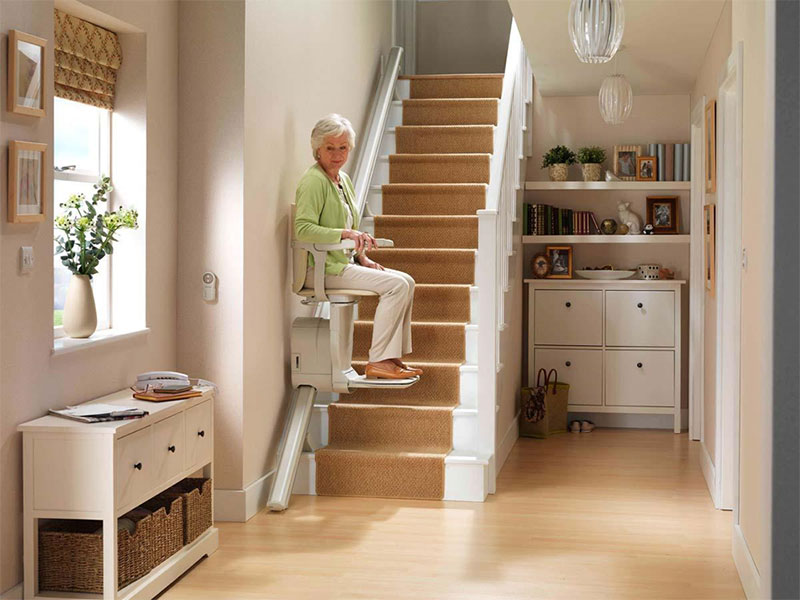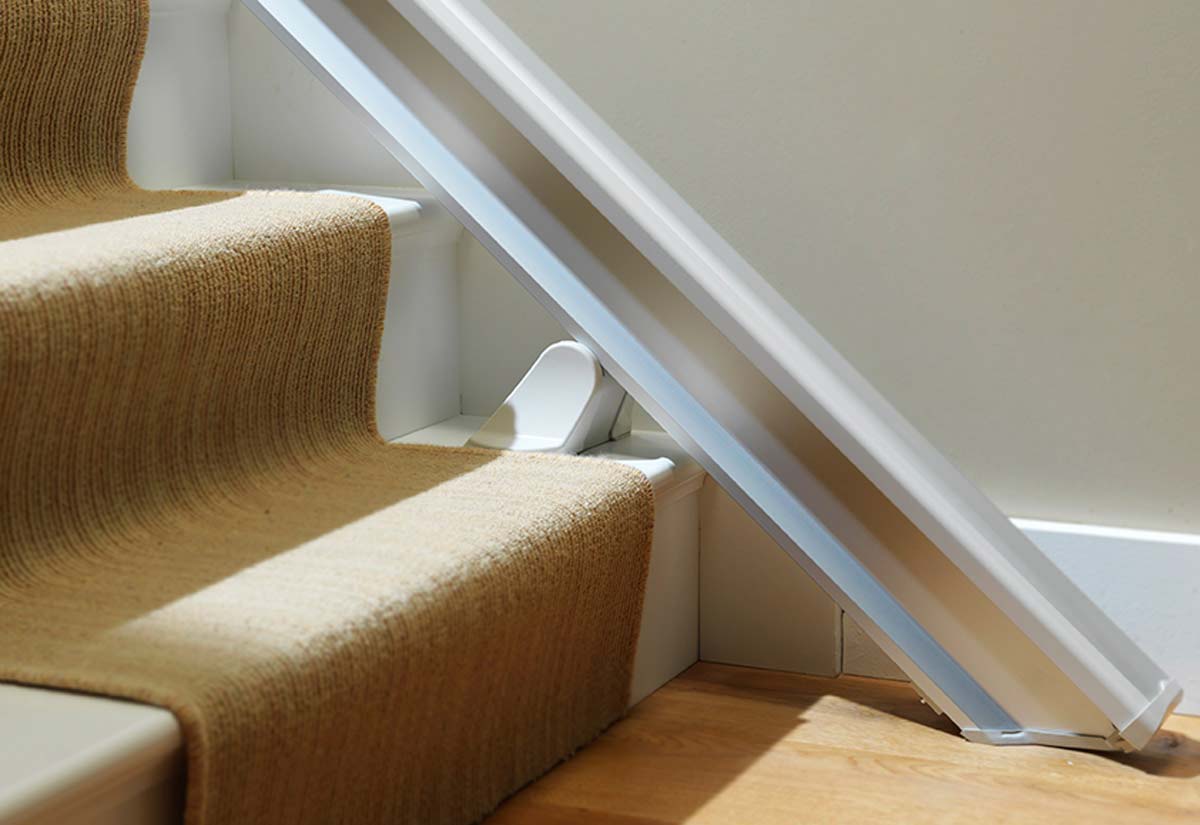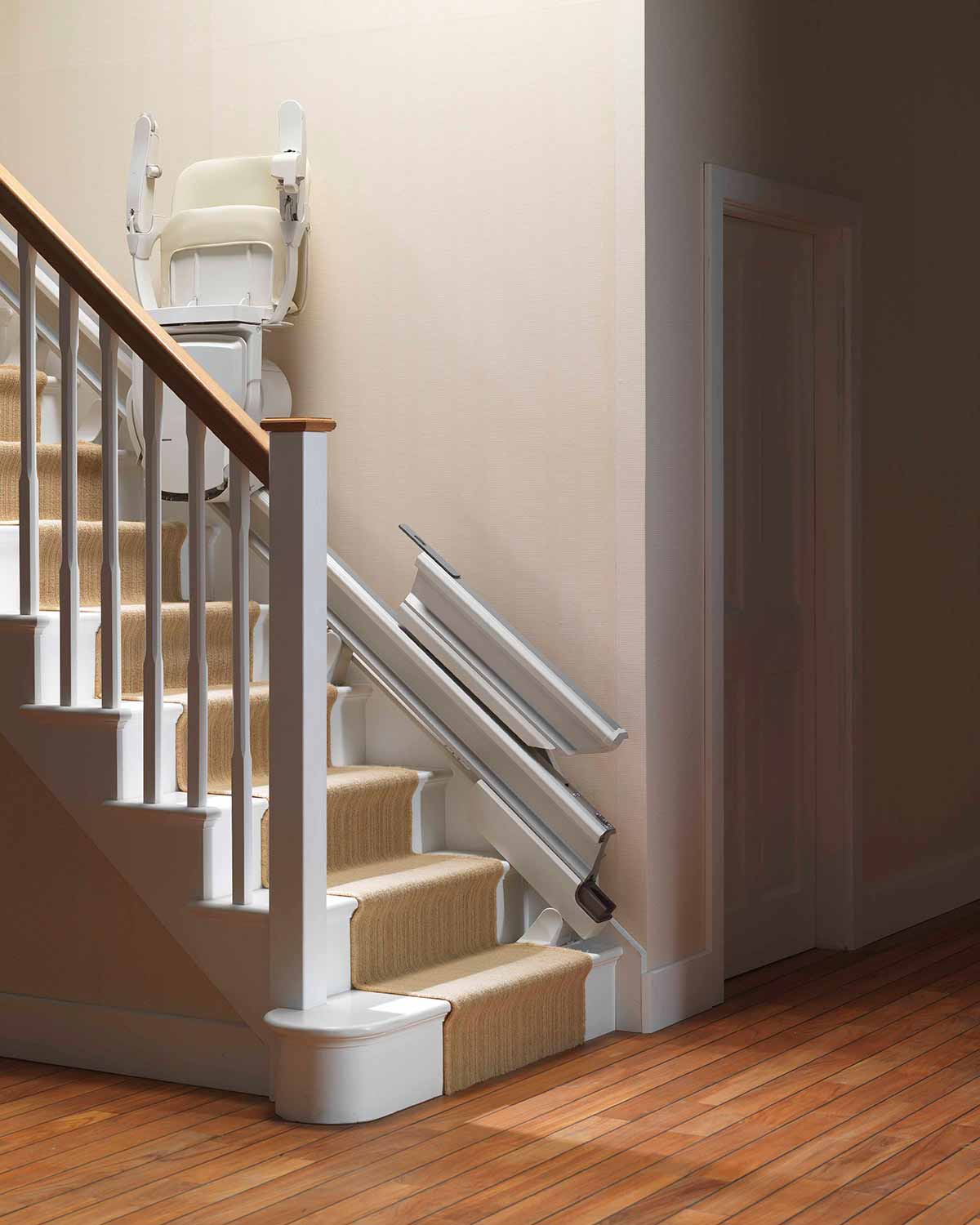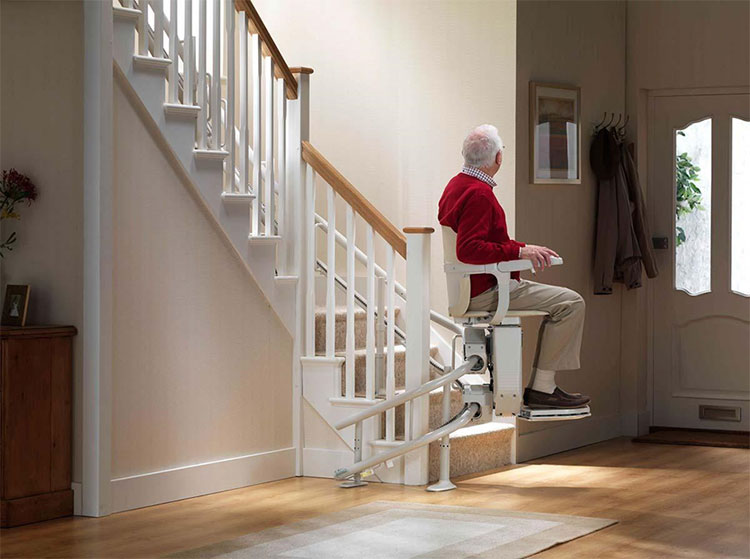Stairlift Rails: what you need to know about rail installation and the stairlift rail you need
Written by Stannah

If you’re considering a stairlift, one of the first things to think about is how it will fit on your stairs. How is the rail secured? How far does the rail stick out past the bottom stair? What is the rail length? Can it go around corners? What if you have a door at the bottom and need the rail to fold up and out of the way?
There are several factors to take into account and it can be difficult to know where to start. Fortunately, we’ve got you covered! In this article, we’ll highlight the different types of stairlift rails, their dimensions and how their various features and options can help make your home safer.
A Guide to the Different Stairlift Rail Types
On a basic level, there are three main types of stairlift rail: straight, curved and outdoor. Each of these rail types is suited to a different type of staircase and the rail type you’ll need will depend on where you want to get your stairlift installed. Let’s take a closer look, so you can figure out which rail option is best for you.
Straight Rail Stairlift
The most basic type of stairlift rail is the straight rail. Straight rails are mass-produced and cut to length, only once they have been ordered for a specific staircase. They’re typically silver or bronze in colour and made of aluminium. The best rails will be anodized and scratch-resistant. Because straight rails are only required to climb the stairs in a straight line, stair width and head clearance are the only real concerns, in terms of your staircase’s dimensions. As long as you have sufficient head clearance for the user and your stairs are a minimum of 71 cm, installing a straight stairlift should be no problem.

Straight Rail Dimensions
As mentioned above, straight stairlift rails require a staircase that is no less than 71 cm wide and has sufficient headroom for the user. Fortunately, straight rails are fitted with a charging strip that provides a constant charge, powering the stairlift’s battery, regardless of where you decide to park the chair. The rail itself only sticks out about 15 cm onto the staircase, leaving plenty of room for others to get by.
Contrary to popular belief, the rail can be fixed to the stair treads or the wall. This is much more secure (and causes far less damage to your home), and requires no big home modifications. This typically requires just a few screws to attach the legs to the treads on every other stair. The only other important factor to consider is that the rail will likely stick out around 46 cm at the bottom of the staircase, so the stairlift has a place to land. If you have a door or walkway at the bottom, you might need to consider some additional options.
Powered Folding or Retractable Rail Option

The Retractable Rail Option, also known as hinged rail, is the perfect solution for obstructed landings at the bottom of a straight staircase. The rail folds up and down with the push of a button, clearing space at the bottom of the stairs and providing a safe landing for your stairlift on the ground floor. Once you’ve disembarked, you can send the stairlift back upstairs remotely and the retractable rail will fold up and out of the way, until you’re ready to use it again.
Curved Rail Stairlift
If your stairs make a turn, have an intermediate landing or include multiple flights, you’ll likely need a curved rail stairlift. Curved rails are more complicated than straights, in that they have to be custom-made to handle the bends and turns of your stairs, while maintaining a smooth and level ride. Unlike straight staircases, where the stair width is relatively consistent, curved staircases often include pie-shaped stairs and variant widths that need to be accounted for.
Curved stairlifts can be installed on either side of the stairs making an inside turn or going around an outside bend. Regardless of which side you choose, precise measurements are critical for designing a safe and reliable curved rail stairlift. Fortunately, there are usually a variety of solutions, as well as a variety of options. You can choose everything from the colour of the rail to how and where the stairlift starts and finishes. Let’s take a closer look.
Types of Curved Rails
There are two major types of curved stairlift: modular and custom-made. As their names imply, one is custom-designed for your stairs, while the other is composed of pre-fabricated parts that are assembled into a completed stairlift rail.
Typically, custom rails (sometimes referred to as bespoke rails) are a tighter fit and offer a smoother ride. The twin-tube design is popular, but the characteristics of the rail can vary, depending on the company you choose.
Modular rails, meanwhile, are often single tube and boast a quicker delivery time. While the ride quality isn’t quite as smooth as a custom rail, in most cases, a modular curved rail does the job just as well. However, it is important to note that if you have a complicated staircase with very tight turns, you might need the superior design of a custom rail.
Typical curved stairlift rail dimensions
Curved rail dimensions vary, depending on the specifics of your staircase. And because each curved staircase is different, it’s hard to give approximate dimensions for stairs that turn.
Long, straight sections can have rail protrusion that are similar to the 15 cm typically seen on straight stairlifts, but it’s difficult to say how far the rail will stick out where it makes corners. However, bespoke rails are known to hug turns significantly tighter than modular stairlift rails.
Curved stairlift rail charging and power
Unlike straight rails, curved rails do not offer a constant charging strip. Instead, they have to meet a silver spring charging point at the top or bottom of the stairs. Only then, will the stairlift’s batteries receive the charge they need.
If you park your stairlift away from the charging point, you will hear a beeping noise, alerting you that your stairlift is not charging. It’s important to keep your stairlift charged, so it’s always ready for use. Otherwise, you might need to have them replaced.
Curved stairlift rail starts and finishes

Sometimes, there isn’t a convenient place to park the stairlift at the top or bottom of the stairs. That’s where alternative curved rail starts and finishes come in handy.
For example, a 180° turn and park is a common example of an alternative rail start. That means at the bottom of the stairs, the rail turns and bends around a wall or bannister, so that the stairlift can be parked and folded up out of the way.
Similarly, an over-run finish at the top of the stairs is an example of an alternative rail finish. Rather than finishing level with the top riser, the curved rail can continue onto the landing, either finishing flat on the top landing or bending around a corner, so as to be even further away from the stairs.
These are just a few examples. There are many other types of rail starts and finishes that can be installed, depending on your home’s architecture and your physical needs.
One innovative option from Stannah is the first riser start which allows the rail to sit within 7.6 cm of the first riser at the bottom of the stairs. That’s less than the typical distance from bottom stair to door frame – a big factor if you have a door at the bottom of the stairs. If you need a curved rail but want to preserve space at the bottom of the stairs or park the stairlift away from the staircase at the top, make sure to ask about alternative rail starts and finishes during your home visit.
Outdoor Stairlift Rails
Finally, let’s talk about rails for outdoor stairlifts. While some companies do carry curved outdoor stairlifts, outdoor rails are typically straight (as most outdoor staircases are). Like, indoor straights, they are cut to length and relatively straightforward in nature. However, unlike indoor rails, they’re sturdily built to withstand fluctuating weather. Rain, snow, salt air, and wild critters won’t stop this rail from getting you out and about. While there are few options for outdoor stairlift rails, this is a genuine four-season product: resilient, reliable and built to last.
Stairlift Rail Options & Design
At Stannah, we are manufacturers, but we are also designers. It’s not only the length and the shape of the rail of your stairlift that can be customized but the rail design itself. If you want your stairlift rail to be discreet or modern to perfectly fit your home décor, you can count on our expertise to exactly match your expectations. After all, it’s not only about accessibility or home modifications: it is also about your place, and about it being just the way you like it. In every single detail. It’s a whole new piece of furniture – and a durable one!
Next Steps
Choosing the right stairlift rail solution for your home can be tricky. That’s why it’s always best to work with an expert, rather than trying to look for something on the second-hand market and installing it yourself. Stannah offers a free stair survey, which can help you get the answers you need. Request an evaluation today and find out which stairlift rail option is best for you.
